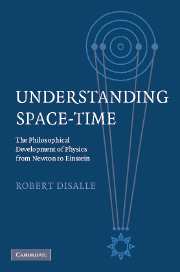5 - Conclusion
Published online by Cambridge University Press: 22 September 2009
Summary
SPACE AND TIME IN THE HISTORY OF PHYSICS
In the history of modern physics, space and time have after all played something like the role attributed to them by Kant. Not as forms of intuition: this was only incidentally the case, in a context where the geometry of space and the intuitive means of knowing about space seemed inseparable from one another. In that context, the processes of “representing to ourselves” in the productive imagination and of conceptualizing the relative situations of physical things appeared to be seamlessly connected. That is, the infinite Euclidean space in which physics treated the positions and motions of bodies was the most straightforward extension of the space in which we move, grasp our relation to our immediate surroundings, and situate our spatial point of view. But they have played the quasi-Kantian role of a framework that enables physics to constructively define its fundamental concepts of force and causality, by giving physics the means to construct such concepts as measurable theoretical quantities. The familiar and vague notion of force, through the work of Galileo, Huygens, Newton, and others, became a physical concept with a constructive spatio-temporal definition, one that did not really violate the common notion – even if it seemed to at first – but that rendered it a powerful tool of physical investigation, and thereby made the discovery of physical forces a clear and attainable goal.
Information
- Type
- Chapter
- Information
- Understanding Space-TimeThe Philosophical Development of Physics from Newton to Einstein, pp. 153 - 162Publisher: Cambridge University PressPrint publication year: 2006
